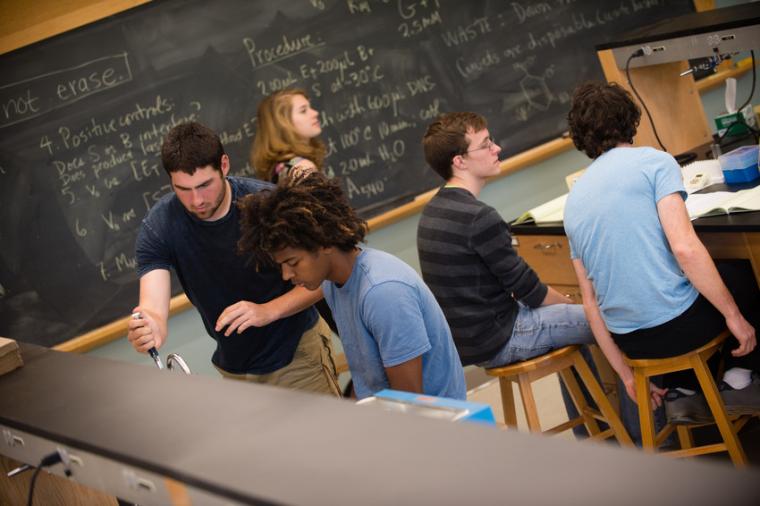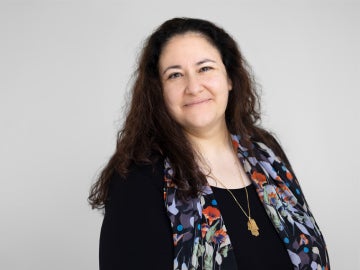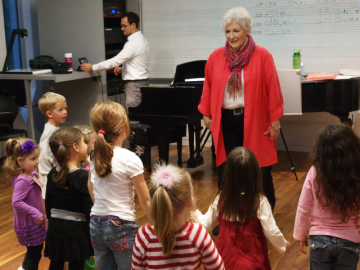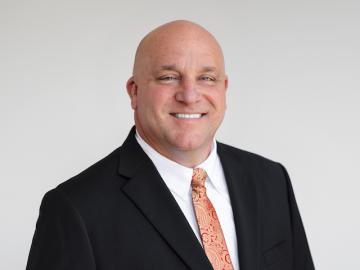Campus News
CLEARly Committed to STEM
May 1, 2013
Cynthia Nickoloff

An Oberlin biochemistry laboratory.
Photo credit: Matt Lester
The Obama administration’s 2014 budget proposal includes a $3.1 billion commitment to science, technology, engineering, and mathematics (STEM) education, underscoring the growing recognition among educators that strong natural science and math programs can strengthen the general liberal arts curriculum and provide students with essential skills for success in the 21st century.
That recognition is not new at Oberlin, where the college has again strengthened its commitment to STEM education by establishing the Center for Learning, Education, and Research in the Sciences (CLEAR) with an $800,000 grant from the Howard Hughes Medical Institute’s (HHMI) Science Education Initiative. CLEAR became fully staffed earlier this year when Marcelo Vinces accepted its directorship and 2012 Oberlin graduate Emily Gazda joined on as administrative assistant.
The center’s goal is to enhance the quantitative and scientific problem-solving skills of Oberlin’s science and math majors through faculty curricular development, workshops, and student peer-led activities, areas that are central to the HHMI project’s goal of improving science teaching and student learning in the sciences.
“HHMI recognizes that the development of strong quantitative problem-solving skills is critical for students to succeed both as STEM majors and throughout their future careers in the increasingly interdisciplinary worlds of science and medicine,” says Oberlin’s HHMI program director Jason Belitsky, associate professor of chemistry and biochemistry.
Like a Writing Center, but for STEM
CLEAR’s services for students will be akin to those offered by the Writing Center, with CLEAR’s programs and trained peer mentors helping natural science and math students strengthen their understanding of quantitative and formal reasoning skills.
The center will provide peer support in such areas as statistics, software, and math that are made use of in a variety of courses, says Vinces.
CLEAR is currently accepting applications for peer tutors and mentors. Applications can be completed online and are available on the CLEAR website. The application deadline is Friday, May 17.
Focus on Visibility
Since arriving on campus barely two months ago, CLEAR’s two-person staff has hit the ground running. Many of their early initiatives have focused on promoting Oberlin’s STEM disciplines and advertising the center’s services.
• A newly launched website for CLEAR not only describes the center and its objectives, but it also features information and links to a variety of on- and off-campus resources, making it a one-stop shop of resources for scientific, mathematical, and quantitative pursuits.
• Students and faculty can connect with CLEAR Twitter.
• On Friday, May 3, the center will host its first annual Lab Crawl. With 22 participating labs and information stations across campus representing every STEM discipline at Oberlin, the event aims to increase student awareness of student-faculty research opportunities.
• A calendar on the CLEAR website displays all campus events relating to science, math, and technology.
“Oberlin already provides a lot of support for math, science, and quantitative skills,” says Vinces. “What the new website, the calendar, and social events like the Lab Crawl do is raise the profile of the great intellectual and physical resources we have on campus, as well as facilitate even greater interactions among different facets of the Oberlin community, whether it be among students of different majors, faculty across departments, or staff in various offices.”
Focus on Resources
Organizing and making accessible current science, math, and technology resources—and adding to them—is another of CLEAR’s objectives. Current programs that CLEAR will administer include the Oberlin Workshop and Learning Sessions (OWLS), a peer group-tutoring program. Drop-in tutoring will be available in fall 2013.
“Peer mentoring has been shown to be an effective way to reinforce student learning of content from lecture courses,” says Vinces, “and the peer mentors themselves benefit by solidifying their knowledge and honing their teaching and mentoring skills. There is rich scholarship in the effectiveness of these peer-led models, and we are eager to do assessment of these programs, as well as perhaps contribute the scholarship on peer-mentoring.”
CLEAR also will sponsor workshops and curriculum development opportunities for faculty. The first workshop, held in January, featured a discussion of teaching quantitative reasoning across the curriculum. A second will take place May 22 and 23, when Corrine Taylor, director of Wellesley’s Quantitative Reasoning Program, leads the workshop “Taking Quantitative Reasoning to the Next Step at Oberlin.”
During the summer, 10 faculty members will develop new course material to strengthen the teaching of quantitative-reasoning skills. The revised courses will be introduced in the 2013-14 academic year.
In the planning stages for fall 2013 is an event examining issues of diversity in the natural sciences that will bring in multiple perspectives from the Oberlin College community and from outside the campus.
You may also like…
Remembering Former Visiting Assistant Professor Leila Ben-Nasr
Leila Ben-Nasr, a former visiting assistant professor of comparative American studies, died on November 28, 2025.
Oberlin Community Remembers a Beloved Retired Professor
A member of Oberlin faculty for 13 years, Peggy Bennett was known by students and the Oberlin community for creating and leading MusicPlay, a preschool classroom and learning lab run as part of the...
Eric Rooks Named Director of Campus Safety at Oberlin
Longtime public servant emphasizes collaborative partnerships and kindness.


